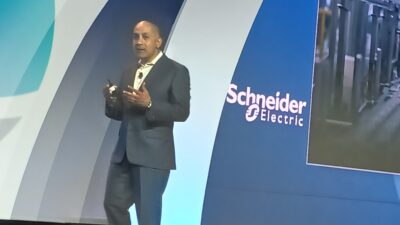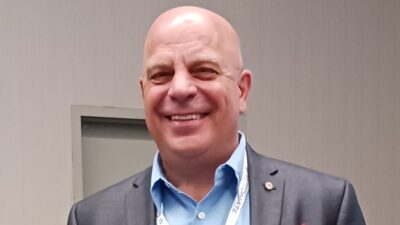Designing equipment and control strategies for a unique one-time radioactive cleanup project took the best engineering collaboration and change management practices of three companies. Figuring out processes to mitigate the world’s single largest source of radon required creative thinking and adaptable equipment.
Designing equipment and control strategies for a unique one-time radioactive cleanup project took the best engineering collaboration and change management practices of three companies. Figuring out processes to mitigate the world’s single largest source of radon required creative thinking and adaptable equipment. The result: a safe project with a best practices award from the U.S. Department of Energy (DOE) and a new park for the people of Fernald, OH.
In 1992, Fluor Fernald began the Fernald closure project for the DOE. Fernald was a uranium refinery complex that covered 1,050 acres and operated from the early 1950s through 1989. Waste products from the refining process were a mixture of heavy metals, organic materials and radioactive elements. The project goal was to remove 8,900 cubic yards of waste that had been stored in two 30 ft. tall and 80 ft. diameter concrete silos for decades. Over the years, unprecedented levels of radon gas had accumulated in the silos, threatening the surrounding community.
According to the U.S. Environmental Protection Agency, residential homes with radon levels of more than four picocuries per liter (pCi/L) pose lung cancer risks. Each silo at the Fernald site contained approximately 13 to 16 million pCi/L—the world’s largest concentration of the colorless, odorless gas. Controlling and mitigating the radon was essential, otherwise workers could not remove the waste.
Teaming up for a solution
System integrator CCA-Wesco’s engineering manager Shirley Jeffreys says conventional methods to develop a control system for this one-of-a-kind processing facility would not have been adequate to meet their accelerated schedule and safety requirements. The solution would demand the best minds, services, and products from Fluor, CCA-Wesco, and Siemens Energy & Automation.
The first step would be to deal with the accumulated gas. Radon in the silos would have to be captured in an adsorption process. The silos were ventilated through charcoal beds where the gas was trapped and decayed. When the level was reduced sufficiently, the silos were opened to bring in mining equipment to clean them out. Contaminated waste material was removed by turning it into slurry using two water jets that were remotely controlled by operators in the control room. The slurry was processed to remove excess water and fed into mixers where fly ash and cement were added to make grout. The grout was pumped into steel containers, inspected, and sealed for shipment to a waste storage facility in Texas.
The process sounds simple enough, but in order to be successful, it had to meet stringent regulatory requirements and prove its ability to operate. Designers had three objectives:
-
First, to protect workers there was a need to maximize remote handling of waste.
-
Second, before starting work they had to prove the control system met functional design and safety requirements.
-
Finally, they had to demonstrate that operators could process waste safely and efficiently.
Fluor Fernald and CCA-Wesco each brought key elements to the project, and their teamwork resulted in a process that the DOE recognized as a Best Practice.
Linking multiple vendor platforms
The Siemens PCS 7 DCS (distributed control system) was the platform chosen, based largely on its ability to provide an operator interface with the system tailored specifically to the customer’s needs. More importantly, it was capable of interfacing with a variety of equipment control schemes. While most of the control and distribution equipment was supplied by Siemens, equipment from 12 different vendors was installed at different times throughout the project.
“Siemens was way ahead of the game in terms of connecting multiple pieces of equipment from different companies,” says Jeffreys. “We would have preferred to have just one system, but that was not going to happen.”
The PCS 7 was introduced with the radon control system. CCA-Wesco developed project control software that integrated plant equipment and vendor systems. While some subsystems had their own programmable logic controllers, Jeffreys said, “they appeared as only one system to operators. The PCS 7 DCS linked every process together via Profibus and Ethernet in all phases. All operations were monitored and controlled by operators in a central control room.”
Frank Showalter, Fernald’s facility operations manager added, “Because of the successful integration, the number of vendor packages did not matter to the operators. The key to success was that operators had a logically presented representation of the plant in a single integrated package.”
Engineers from CCA-Wesco worked closely with project engineers, operations personnel, Siemens, and other vendors to integrate the process on the PCS 7 DCS. Based on the experience with the radon control system, Fluor opted to develop the final two phases of the project with CCA-Wesco using the Siemens PCS 7 systems. CCA-Wesco had worked closely with Fernald personnel during development and startup, so transitioning the workforce into the next phase of the project took less time.
Validation, verification, and training
CCA-Wesco had the configuration management system that enabled Fernald to prove to federal auditors that the process control code met all design and nuclear safety requirements. The system tracked requirements, providing an audit trail linking requirements to system capabilities. It also tracked changes to the code, ensuring none of the requirements were lost with process refinements. With the requirements completely documented, CCA-Wesco and the Siemens PCS 7 provided additional value.
“Two steps are used to verify and validate what is going on with the system. The PCS 7 process object viewer allowed us to audit all the alarm messages and priorities—an absolute vital part of this project,” says Jeffreys. “It helped us make sure interlocks and all alarms were in place. Additionally, a simulation station in the control room played an important role. The second step is to verify that the automation functionality is in place and works appropriately. We could not have proven the software prior to completion of construction and installation without the process simulation. We wrote a full process simulation for every system and any changes were tested prior to implementation.”
Showalter said the simulation was vital because it helped speed the development. For example, the team was able to verify the control strategy and ability to transfer and process hazardous material during the code development before construction was complete. The process could be evaluated in the control room and during interactive Web meetings allowing personnel in multiple locations to collaborate easily on the project.
In addition to confirming that the control system worked, the simulator provided realistic, hands-on training. Operators practiced work evolutions before equipment was installed to develop their skills and validate operating procedures. Their view of the process was identical to normal process operation and they could experience the impact of their inputs. Additionally, engineers could simulate process upsets so that operators could learn to recognize abnormal conditions before emergencies developed. Operators gained experience before they processed hazardous material, enabling them to demonstrate that they were capable of operating safely.
Cooperation is key
Reflecting on the success of the Fernald closure project, Showalter said his goal in 1995 was to put himself out of a job by spring of 2006. By all measures, the project succeeded because of the teamwork embraced by everyone involved.
“We succeeded because we had a control strategy that allowed us to process material without coming in direct contact,” says Showalter. “We were able to demonstrate that our process considered the hazards of the job and met all design and safety requirements. That is the way a partnership should work.”
Jeffreys added, “A project like this had never been done before, and it will never be done again. Today, the silos are gone and so is the processing facility.” The entire operation has been demolished, approximately three years ahead of schedule. The land, now free of radioactive materials, has been transformed into woodlots, prairie and open water. Fluor declared the cleanup complete in October of 2006. In late 2007 the DOE Office of Legacy Management will open an education center near where Fernald’s silos once stood.
| Author Information |
| Todd Stauffer is PCS 7 product manager, Siemens Energy & Automation. Reach him at [email protected] . |



